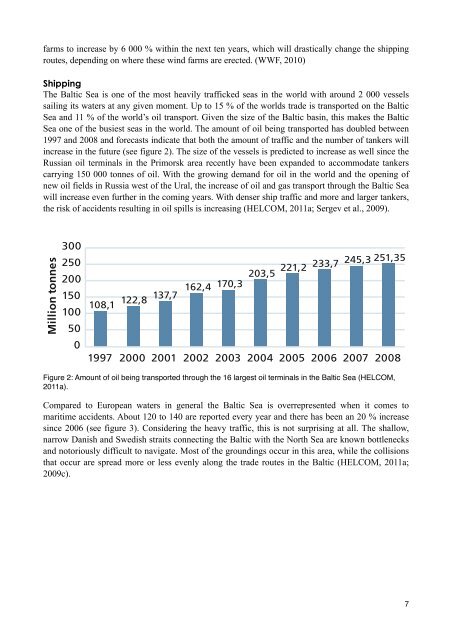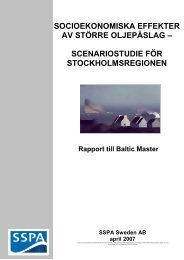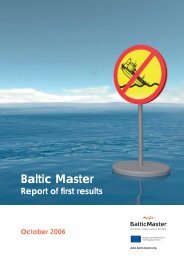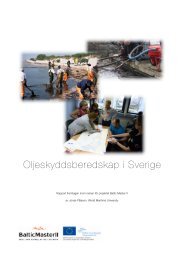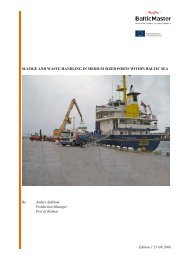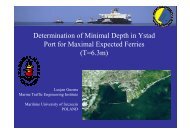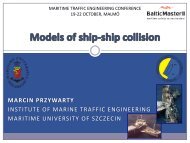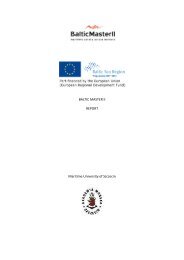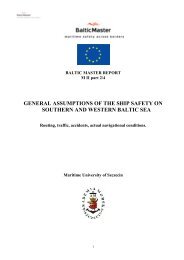Oil Spill Preparedness in the Baltic Sea Countries (9 ... - Baltic Master
Oil Spill Preparedness in the Baltic Sea Countries (9 ... - Baltic Master
Oil Spill Preparedness in the Baltic Sea Countries (9 ... - Baltic Master
You also want an ePaper? Increase the reach of your titles
YUMPU automatically turns print PDFs into web optimized ePapers that Google loves.
farms to <strong>in</strong>crease by 6 000 % with<strong>in</strong> <strong>the</strong> next ten years, which will drastically change <strong>the</strong> shipp<strong>in</strong>groutes, depend<strong>in</strong>g on where <strong>the</strong>se w<strong>in</strong>d farms are erected. (WWF, 2010)Shipp<strong>in</strong>gThe <strong>Baltic</strong> <strong>Sea</strong> is one of <strong>the</strong> most heavily trafficked seas <strong>in</strong> <strong>the</strong> world with around 2 000 vesselssail<strong>in</strong>g its waters at any given moment. Up to 15 % of <strong>the</strong> worlds trade is transported on <strong>the</strong> <strong>Baltic</strong><strong>Sea</strong> and 11 % of <strong>the</strong> world’s oil transport. Given <strong>the</strong> size of <strong>the</strong> <strong>Baltic</strong> bas<strong>in</strong>, this makes <strong>the</strong> <strong>Baltic</strong><strong>Sea</strong> one of <strong>the</strong> busiest seas <strong>in</strong> <strong>the</strong> world. The amount of oil be<strong>in</strong>g transported has doubled between1997 and 2008 and forecasts <strong>in</strong>dicate that both <strong>the</strong> amount of traffic and <strong>the</strong> number of tankers will<strong>in</strong>crease <strong>in</strong> <strong>the</strong> future (see figure 2). The size of <strong>the</strong> vessels is predicted to <strong>in</strong>crease as well s<strong>in</strong>ce <strong>the</strong>Russian oil term<strong>in</strong>als <strong>in</strong> <strong>the</strong> Primorsk area recently have been expanded to accommodate tankerscarry<strong>in</strong>g 150 000 tonnes of oil. With <strong>the</strong> grow<strong>in</strong>g demand for oil <strong>in</strong> <strong>the</strong> world and <strong>the</strong> open<strong>in</strong>g ofnew oil fields <strong>in</strong> Russia west of <strong>the</strong> Ural, <strong>the</strong> <strong>in</strong>crease of oil and gas transport through <strong>the</strong> <strong>Baltic</strong> <strong>Sea</strong>will <strong>in</strong>crease even fur<strong>the</strong>r <strong>in</strong> <strong>the</strong> com<strong>in</strong>g years. With denser ship traffic and more and larger tankers,<strong>the</strong> risk of accidents result<strong>in</strong>g <strong>in</strong> oil spills is <strong>in</strong>creas<strong>in</strong>g (HELCOM, 2011a; Sergev et al., 2009).accidents is about ten times higher than <strong>the</strong> shipisofl-ndre<strong>in</strong>gMillion tonnes300250200150100500108,1 122,8 137,7 162,4 170,3 203,5 221,2 233,7 245,3 251,351997 2000 2001 2002 2003 2004 2005 2006 2007 2008ers),rsa<strong>in</strong>icalheFigure 2: Amount of oil be<strong>in</strong>g transported through <strong>the</strong> 16 largest oil term<strong>in</strong>als <strong>in</strong> <strong>the</strong> <strong>Baltic</strong> <strong>Sea</strong> (HELCOM,2011a).Figure 9. Amount of oil transported via <strong>the</strong> 16 largest oilterm<strong>in</strong>als <strong>in</strong> <strong>the</strong> <strong>Baltic</strong> <strong>Sea</strong> dur<strong>in</strong>g 1997, and 2000-2008.Compared to European waters <strong>in</strong> general <strong>the</strong> <strong>Baltic</strong> <strong>Sea</strong> is overrepresented when it comes tomaritime accidents. About 120 to 140 are reported every year and <strong>the</strong>re has been an 20 % <strong>in</strong>creases<strong>in</strong>ce 2006 (see figure 3). Consider<strong>in</strong>g <strong>the</strong> heavy traffic, this is not surpris<strong>in</strong>g at all. The shallow,narrow Danish and Swedish straits connect<strong>in</strong>g <strong>the</strong> <strong>Baltic</strong> with <strong>the</strong> North <strong>Sea</strong> are known bottlenecksand notoriously difficult to navigate. Most of <strong>the</strong> ground<strong>in</strong>gs occur <strong>in</strong> this area, while <strong>the</strong> collisionsthat occur are spread more or less evenly along <strong>the</strong> trade routes <strong>in</strong> <strong>the</strong> <strong>Baltic</strong> (HELCOM, 2011a;2009c).Ground<strong>in</strong>gs <strong>in</strong> <strong>the</strong> <strong>Baltic</strong> <strong>Sea</strong>are more likely than collisionsThe outcome of <strong>the</strong> overall risk assessment with<strong>in</strong><strong>the</strong> Project ‘Sub-regional risk of spill of oil andhazardous substances <strong>in</strong> <strong>the</strong> <strong>Baltic</strong> <strong>Sea</strong>’ (BRISKProject) as well as BRISK-RU Project (www.brisk.helcom.fi) shows that <strong>the</strong> likelihood of ground<strong>in</strong>gPart-f<strong>in</strong>anced by <strong>the</strong> EuropUnion (European RegionalDevelopment Fund)7


